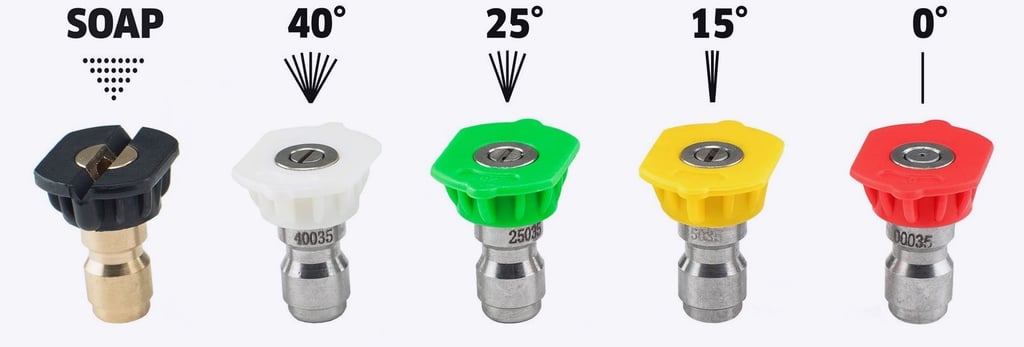Choosing the Right Nozzle for Pressure Washing: A Detailed Guide for Various Surfaces
Choosing the Right Nozzle for Pressure Washing: A Detailed Guide for Various Surfaces
EXTERIOR CLEANING SERVICE PROCESSESBASIC HOME MAINTENANCECURB APPEALPRESSURE WASHING SERVICES


Understanding Nozzle Degrees: 40°, 25°, 15°, and 0°
In pressure washing, the nozzle degree is a critical factor that directly influences the efficiency and safety of the cleaning process. Nozzles are categorized by their spray angles: 40°, 25°, 15°, and 0°, each suited for specific applications and surfaces. Understanding these differences helps in selecting the right nozzle to maximize cleaning power while protecting surfaces from damage.
The 40° nozzle is characterized by its broad spray angle, providing a gentle water stream. This nozzle is ideal for cleaning delicate surfaces such as painted walls, windows, and cars where minimal pressure is required to prevent surface damage. The wide angle disperses the water over a larger area, reducing the impact force while maintaining effective cleaning.
The 25° nozzle strikes a balance between power and coverage. It is commonly used for general cleaning tasks around homes and commercial areas, including driveways, sidewalks, and wooden decks. This nozzle provides a more concentrated stream compared to the 40° nozzle, making it effective for removing moderate dirt and grime without posing significant risks to most surfaces.
Moving to a narrower angle, the 15° nozzle delivers a powerful and more focused spray. This high-pressure stream is suitable for tougher cleaning jobs, such as removing stubborn stains, grease, and heavy mildew on hard surfaces like concrete and brick. While very effective, it requires careful handling to avoid etching or damaging softer materials.
The 0° nozzle, with the narrowest spray angle, produces an intense, pinpoint jet of water. It is designed for spot cleaning extremely tough stains or caked-on debris and is generally reserved for small, highly resistant areas. Given its forceful and concentrated stream, using the 0° nozzle improperly can result in severe surface damage. Thus, it must be used with precision and care, often in conjunction with other, broader-angle nozzles to achieve comprehensive cleaning without unintended harm.
Choosing the correct nozzle degree for pressure washing is essential to optimize cleaning performance and safeguard different surfaces. By matching the spray angle to the task at hand, one can achieve effective results while preserving the integrity of the materials being cleaned.
Selecting Nozzles for Specific Surfaces: Concrete, Brick, Vinyl, and Painted
When pressure washing, selecting the appropriate nozzle for each specific surface is essential to achieve optimal cleaning without inflicting damage. Each type of surface—concrete, brick, vinyl, and painted—requires distinct considerations and pressure settings to ensure safety and cleanliness.
Concrete: To effectively clean concrete driveways, such as sidewalks and patios, a higher pressure setting is usually required. Nozzles with a 25-degree or 15-degree angle can be most effective for this purpose. These nozzles deliver a strong and focused stream that can break through tough dirt, grime, and stains effectively. However, caution must be exercised to avoid positioning the nozzle too close to the surface or using overly high pressure, as this can erode the concrete or etch unwanted marks. It's advisable to maintain a reasonable distance and move the nozzle in a sweeping motion.
Brick: Brick walls necessitate a more cautious approach due to their porous and fragile nature. A nozzle with a wider angle, such as 25-degree or 40-degree, is recommended to minimize the risk of damage. This choice allows for sufficient cleaning power without exerting too much pressure, which can cause the mortar between bricks to crumble. Additionally, it’s crucial to test on a small area before proceeding with the entire surface to ensure the chosen pressure is appropriate.
Vinyl: Cleaning vinyl sidings involves balancing effective dirt removal with the risk of stripping the paint. For this task, a nozzle with a 25-degree angle offers a good balance of pressure and safety. It delivers a stream powerful enough to clean the surface without causing damage. Users should be cautious not to hold the nozzle too close to the vinyl siding to prevent stripping off any paint and always spray at a consistent distance.
Painted Surfaces: Painted surfaces are the most delicate and therefore require the gentlest settings. A 40-degree nozzle is ideal for such surfaces, as it disperses the pressure over a wider area, reducing the risk of chipping or peeling the paint. Lower pressure settings and greater nozzle-to-surface distances are paramount to maintaining the integrity of the paint layer. It's best to start with the lowest pressure setting and gradually increase only if necessary.
By understanding the specific needs and vulnerabilities of each surface type, selecting the appropriate pressure washing nozzle becomes a process of precision and care, resulting in effective cleaning outcomes and preserved surfaces.
Pressure Washing Wooden and Pool Decks: Preserving with Proper Nozzle Choice
When maintaining the aesthetic and structural integrity of wooden and pool decks, proper pressure washing techniques are essential. Wooden decks, in particular, are prone to splintering and damage if subjected to high-pressure settings. To prevent such issues, it is crucial to use wider angle nozzles, such as the 40-degree or 25-degree varieties. These nozzles disperse the water in a broader pattern, reducing the direct impact on the wood fibers, which helps preserve the deck's surface.
For wooden decks, begin by assessing the condition of the wood. Older, more weathered wood can be more susceptible to damage and may require extra caution. Use the 40-degree nozzle first, testing a small inconspicuous area to ensure that the pressure is adequate without causing harm. If additional cleaning power is needed, gradually move to a 25-degree nozzle, while always maintaining a safe distance of 8 to 12 inches from the surface.
Pool decks, often made of concrete, stone, or composite materials, also require careful handling. Using a high-pressure setting can damage sealants and surface coatings, leading to premature degradation. Similar to wooden decks, using wider angle nozzles is recommended to minimize potential harm. A 40-degree nozzle is often sufficient for removing algae, dirt, and other contaminants while maintaining the integrity of the surface. Regular maintenance of pool decks with appropriate nozzle selection helps sustain their appearance and functionality.
When pressure washing either type of deck, it's essential to use the correct pressure settings. Generally, a pressure range between 500 to 1,200 PSI is sufficient for wooden decks, while pool decks may tolerate slightly higher pressures, depending on the material. Always follow the manufacturer's guidelines for both the pressure washer and the specific surface you are cleaning.
In summary, achieving a clean and well-preserved deck, whether wooden or pool, hinges on the careful selection of nozzle angles and pressure settings. By adhering to these best practices, you can extend the life and beauty of these outdoor surfaces.
